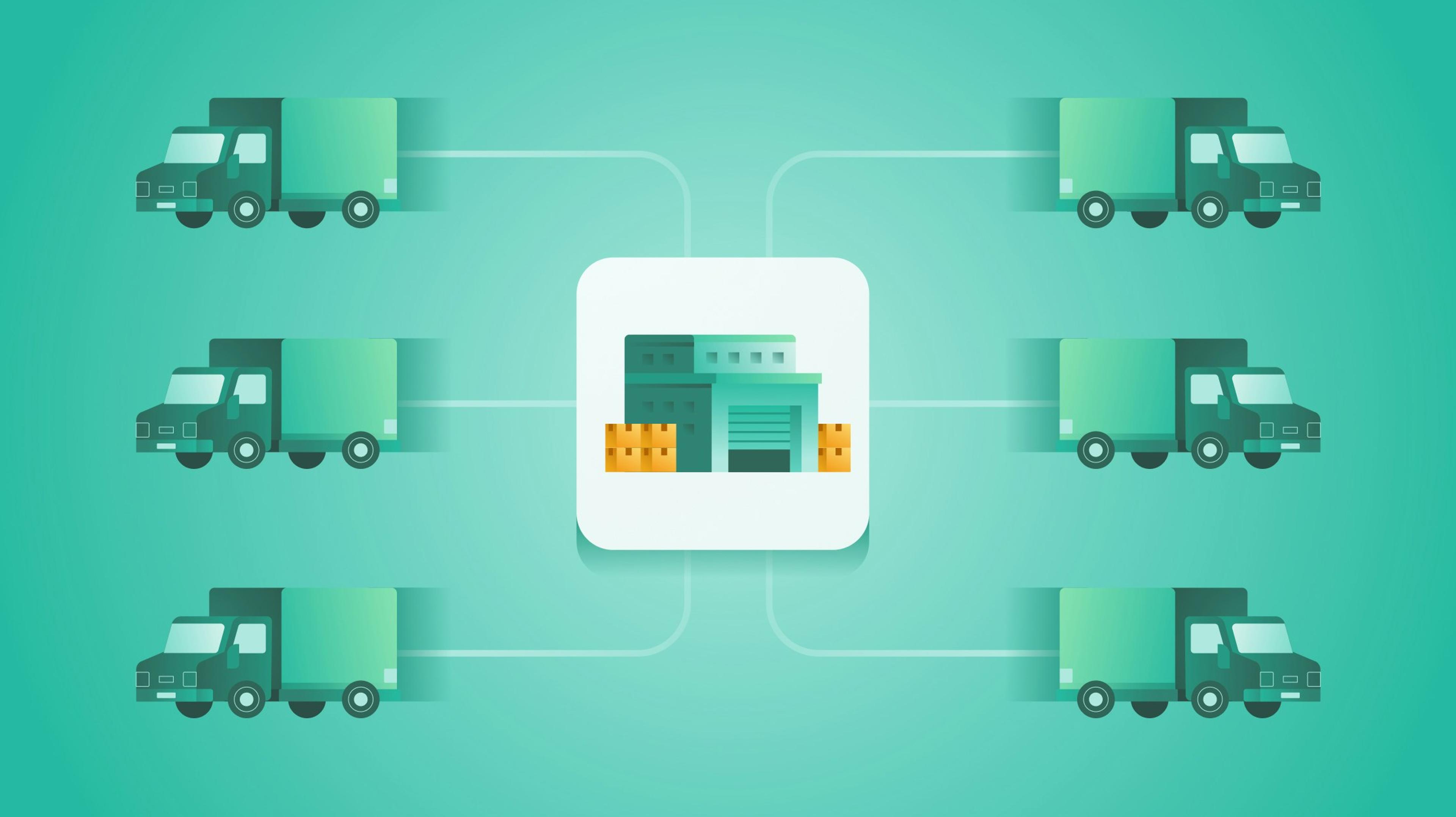What Is Line Haul Transportation? Everything You Need To Know

Manage drivers and operate depot networks with ease using Circuit for Teams.
Line haul transportation is the art of efficiently moving products over long distances and weaving together the threads of the supply chain.
Manufacturers create, retailers distribute, and the space between is where the magic of line haul transportation happens.
If you want to be sure your products reach their intended locations promptly and dependably, the right tools can make all the difference.
In this article, we’ll explain the line haul shipping process and share tools and best practices for optimizing your line haul logistics.
By the end, you’ll gain the knowledge needed to make well-informed decisions, amplify customer satisfaction, and pave the way for operational excellence.
Key takeaways
- Line haul transportation is the backbone of long-distance logistics, connecting manufacturers and retailers.
- Embrace modern tools to optimize routes and streamline operations for maximum efficiency in your line haul operations.
- Implement innovative tools and strategies like asset tracking to navigate the complexities of line haul transportation, enhance customer satisfaction, and drive success.
- Stay ahead of the game by gaining real-time updates on shipments so you can make informed decisions and be sure products reach their destinations promptly.

What is line haul transportation?
Line haul transportation refers to the long-distance movement of goods without any intermediate pickups or drop-offs.
It’s the main leg or “backbone” of a longer transportation journey, which might also include smaller, localized transportation at either end (like last-mile delivery to a residence or business).
Line haul services often transport bulk goods or large quantities (think pallets or raw materials) to achieve cost-efficiency over longer distances.
Line haul can involve different modes of transportation, including trucks, trains, and planes, but you might associate line haul transportation mainly with trucks.
What is a line haul carrier?
A line haul carrier is a shipping service provider that specializes in transporting goods over extended distances, beyond local or regional boundaries.
Their trucks are built for endurance, designed to handle long hours on the road and to carry large quantities of goods efficiently and securely.
Line haul drivers often operate on established long-distance routes between terminals, hubs, or depots.
While many trailers in the transportation industry are optimized for quick loading and unloading, line haul trailers are especially suited for this, and they often have a larger capacity to accommodate the demands of long-distance transportation.

Line haul vs. long haul trucking
While both line haul and long haul trucking involve the transportation of goods over extended distances, they have distinct operational differences.
Long haul trucking can be compared to exploring various destinations on a long journey, potentially spanning coast-to-coast distances. Drivers in this category might be on the road for weeks, making multiple stops or deliveries along their route.
Line haul, in contrast, is more about direct routes between specific points, like terminals or hubs, often with minimal or no intermediate stops. Because of this regularity, line haul drivers often work on predictable schedules, but this doesn’t necessarily mean they return home frequently.
While long haul can be seen as a varied and extended journey, line haul is a consistent and direct transit between two defined points.
Less-than-truckload (LTL) vs. full truckload (FTL)
Less-than-truckload (LTL) and full truckload (FTL) are two common shipping options used in the transportation industry.
LTL is like sharing a taxi with others. It’s tailored for shipments that don’t require the entire space of a truck. Different customers’ freight is consolidated into one truck, making it a cost-effective option for smaller shipments.
On the other hand, FTL is like reserving the entire taxi for yourself. It caters to larger shipments that can occupy or nearly occupy the full space of the truck.
With FTL, the truck transports only your goods directly from the pickup point to the destination, making it a preferred option for sizable or sensitive shipments that may benefit from minimal handling.
Importance of line haul carrier tracking
In the modern era of logistics, tracking has evolved from a cool feature into a must-have tool in the arsenal of carriers. It’s become an essential aspect of offering efficient, reliable, and customer-centric operations.
- Get real-time insights. Tracking offers the power of real-time insight into the location and status of your freight. It’s like having a virtual window into the journey, allowing you to monitor progress at every turn.
- Stay on schedule. Line haul tracking isn’t just about watching a dot move across a map — it also helps keep deliveries on time. By keeping tabs on the truck, dispatchers can swoop in and make adjustments if there’s a hiccup or a potential delay to keep things moving.
- Mitigate risks and solve problems quickly. One of the best things about tracking is its ability to mitigate risks before they snowball into problems. Whether it’s an unexpected traffic snarl or an unforeseen weather twist, carriers armed with real-time tracking data can reroute and pivot seamlessly.
Ever wondered how all this tracking magic unfolds? It’s the result of cutting-edge digital tools and technology — think GPS systems, satellite communication, Internet of Things (IoT) sensors, and smart data analytics working together in harmony.
These tools form the backbone of tracking, allowing carriers to monitor their teams, predict potential hiccups, and optimize routes for peak efficiency.
Advantages of line haul trucking
These advantages contribute to a streamlined and efficient transportation process that benefits both businesses and customers alike.
- Cost-efficiency. Line haul trucking offers cost savings through bulk transportation. By moving goods directly between hubs or depots, businesses can save on fuel and labor costs, as well as reduce the expenses associated with frequent stops and detours.
- Faster delivery times. Since line haul operations focus on transporting goods over longer distances without the need for numerous stops, it often results in quicker delivery times. This direct approach makes sure that goods reach their destination or the next sorting point more swiftly.
- Enhanced tracking and visibility. With the adoption of modern digital tools like delivery software, line haul trucking gives shippers real-time insights into their shipment’s location and status. This real-time tracking offers transparency and timely updates.
- Optimized resource utilization. Line haul operations make sure trucks are used to their full capacity, minimizing instances of partially filled trucks. This optimal use of resources delivers maximum value for each trip.
- eCommerce integration. The rise in eCommerce has increased the demand for line haul services due to the sheer volume of goods being ordered online and the need for efficient transportation to meet delivery promises. Line haul trucking makes sure goods are transported from warehouses to sorting hubs and to their final delivery points.
- Reduced handling. Transporting goods directly between primary locations or hubs means there’s less handling involved. This can lead to fewer instances of damage or misplacement.
5 line haul optimization tips
Optimizing your line haul operations is key to staying ahead. Here are some tried-and-true strategies to enhance efficiency, reduce costs, and elevate customer satisfaction.

1. Optimize routes
When it comes to line haul optimization, selecting the right path can make all the difference — and choosing the most efficient routes isn’t just about getting from point A to point B.
Route optimization is about finding the optimal route for drivers — the one that shaves off unnecessary time, reduces fuel consumption, and makes sure deliveries arrive on time.
In the past, route planning might have involved some educated guesswork. Today, we have modern mapping and GPS technologies at our fingertips.
These tools analyze traffic patterns, road closures, and even weather conditions in real time. This means your drivers can take the scenic route around traffic jams and navigate detours without breaking a sweat.
By analyzing real-time traffic data, you can choose alternate routes and bypass congested areas. When facing natural challenges, technology can help you find the most feasible and time-efficient way around them.
With the aid of delivery software, line haul carriers can outsmart traffic, tackle natural barriers, and be sure their cargo reaches its final destination with maximum efficiency.
2. Analyze in real time
Real-time data is like having a crystal ball for your operations. It’s not just about knowing what’s happening right now — it’s about foreseeing what’s about to happen and how you can respond in the best possible way.
Real-time analysis turns hunches into calculated moves. With instant insights, decision-makers can act on the spot by rerouting a truck to avoid a sudden traffic jam or shifting resources to meet a sudden spike in demand.
Real-time data lets you pivot, reroute, and sidestep disruptions before they escalate into full-blown problems. It also alerts you to potential delays, so you can tweak schedules, reroute, and keep your promises to customers.
With instant insights, line haul carriers can make split-second decisions, stay ahead of disruptions, and be sure their deliveries are as reliable as clockwork.
3. Implement digital tools for carrier tracking
The evolution of transportation is tightly linked with technology. Digital tracking tools have revolutionized the industry, offering real-time visibility and accountability.
With digital tracking, you gain a constant view of your line haul network. No more paper logs or guesswork. These tools have modernized processes, boosting efficiency and precision.
Updates on location, status, and conditions are at your fingertips, building confidence and trust. Carriers are more accountable, and goods follow the right routes and schedules.
Real-time visibility and accountability empower carriers to make informed decisions, optimize routes, and update customers transparently. This means better decisions, lower risks, and a better customer experience.
4. Adopt dynamic pricing
The cost of transportation adjusts in real time based on demand, supply, and external factors. Think of dynamic pricing as a flexible melody, not a fixed tune.
Several elements shape dynamic pricing in transportation services:
- Demand shifts. There is typically a surge in trucking demand during holidays, so dynamic pricing responds by raising rates, while slower periods might see lower prices to attract business.
- Fuel fluctuations. Fuel costs are unpredictable. Dynamic pricing considers these changes, adjusting rates when fuel prices rise significantly.
- Seasonal changes. Seasonal shifts impact rates. For example, challenging winter roads might lead to higher prices due to increased risk.
By responding in real time, transport companies optimize their line haul charges to increase profits while staying competitive in the logistics marketplace.
5. Integrate third-party logistics
Partnering with a third-party logistics (3PL) provider is a smart move in the intricate dance of line haul operations.
3PLs are logistics experts, well-versed in trends and technology. Integrating them enhances processes, routes, and overall efficiency in line haul operations.
Teaming up with a 3PL also means expanding services without extra costs. They handle tasks like route planning and warehousing, letting carriers focus on the movement of goods.
This means smoother operations and potentially lower expenses.
Their expertise, services, and cost-effectiveness elevate efficiency, widen reach, and position you for success in logistics.
Optimize line haul logistics with Circuit for Teams
With Circuit for Teams, you can revolutionize how you manage your line haul operations. Say goodbye to inefficiencies and hello to optimized routes, real-time tracking, detailed records, and effortless communication.
Keep your finger on the pulse of your operations with real-time tracking. Whether it’s monitoring deliveries or adjusting routes on the fly, Circuit for Teams keeps you in control and your customers satisfied.
Communication is key. With Circuit for Teams, you can coordinate with your team members, assign tasks, and keep everyone on the same page for a smoother workflow.
Ready to transform your line haul logistics into a well-oiled machine? Sign up for Circuit for Teams today!


